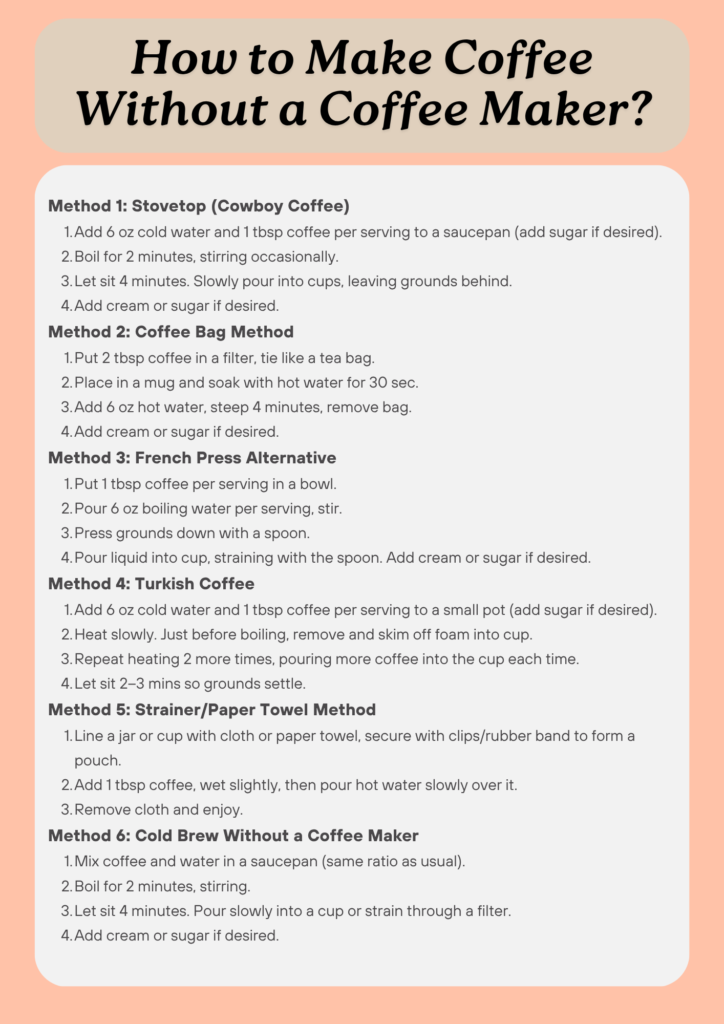It’s a smart idea to have a coffee maker, especially if you’re as addicted as I am. There are various excellent models available. However, you can still make a cup of life-giving elixir with just a pot of water, some ground beans, and a heat source if you don’t have the counter space for a large machine (which is a very real problem), your French press is busy making cocktails or extracting liquid from zucchini, or you’re, you know, camping or something.
Essential Items You’ll Need
Find out when your beans were born. We mean roast date by that. If you use beans that have been roasted within two weeks, you will get the greatest homemade coffee.
Make use of the freshest coffee you can. To get the best flavor, purchase the beans whole and ground them to your desired coarseness using a device like a Kitchenaid Coffee Bar Coffee Grinder.
Take care of the temperature. Around 200° Fahrenheit is the recommended temperature for water needed to brew coffee.
Method 1: The Stovetop (Cowboy Coffee)
If you don’t have a microwave, this is a classic, old-fashioned method of making coffee. If you have a gas range, it will also function in the event that you are without power.
- Coffee making should begin with six ounces of cold water. Next, fill a small saucepan with water and place it over medium-high heat.
- Pour 1 spoonful of coffee into the pan for each serving. Now, if you like, add sugar.
- The coffee mixture should be brought to a boil.
- After two minutes of boiling, stir from time to time.
- Take off the heat, leave it for four minutes, and then carefully pour the coffee out of the pan, making sure the coffee grinds stay in the pan and not in your cup or cups.
- If desired, add cream and/or sugar.
Method 2: The Coffee Bag Technique
Fill up on filter beans for this stovetop approach if you like your coffee less bitter.
- Pour in two tablespoons of coffee and place one filter on the counter. (We demand more in this approach to take into consideration the filter and the amount of flavor that can “escape.”)
- Tie the filter with thread after bringing its ends together. Consider a package that resembles a tea bag. This bag should be put in your coffee cup.
- Heat the water in a small saucepan until it boils.
- Soak the coffee grinds for 30 seconds after soaking the bag in enough water to cover them.
- Fill your coffee cup with six ounces of water.
- After 4 minutes of steeping, take the bag off.
- If desired, add cream and/or sugar.
Method 3: Using a French Press Alternative
Use a mug, bowl, and spoon to simulate the effects of a French press coffee machine.
- Bring a saucepan of water to a boil over the stove.
- Put 1 tablespoon of coffee each serving in a large bowl.
- Add 6 ounces of water each serving after saturating the grounds with a tiny bit of boiling water.
- Press the coffee grinds to the bottom of the basin using a spoon.
- Pour the leftover liquid into your coffee cup or cups, pressing the spoon down on top of the grounds.
- If desired, add cream and/or sugar.
Method 4: Turkish Coffee
A thick, foamy, and strong brew is produced with this method, which is a little fussier than stovetop coffee. Although it’s not a completely traditional approach, it’s one way to create an extremely strong cup of Turkish coffee. Indeed, the final cup should contain the grinds.
- For each dish, start with 6 ounces of cold water. Next, fill a small pot with water and place it over low heat.
- Pour 1 spoonful of coffee into the pan for each serving. Now, if you like, add sugar.
- Remove the water from the heat and whisk the foam when it’s almost boiling.
- Fill your coffee cup or cups with foam.
- Put the pan back on the burner and wait for it to come close to boiling again, then turn off the heat.
- Fill your coffee cup or cups with half of the coffee.
- Put the pan back on the burner. After 15 more seconds of boiling, turn off the heat.
- Fill the coffee cup or cups with the full mixture. To allow the coffee to sink to the bottom, let it sit for two or three minutes.
Method 5: The Strainer or Paper Towel Method
Who would have thought that a simple handkerchief would play such an important role in making coffee? For this procedure, you will need a few binder clips or simple clothespins.
- Attach the fabric to the glass jar using a clip. Using the clips or a sturdy rubber band, cover the jar with the hankie (you may also use any clean cotton fabric). Give the fabric enough wiggle room to fit into the jar like a pouch.
- Coffee should be scooped onto the cloth. After scooping one cup of coffee grinds into the hankie pouch, cover the grounds with a small amount of water to allow them to soak.
Cover the grounds with water. After removing the hankie and grounds, slowly pour the remaining water over them and enjoy!
Method 6: Cold Brew Without a Coffee Maker
- Put coffee grinds and water in a saucepan. Use the same proportion of water to grinds as you would in a coffee machine.
- Bring to a boil. Bring the coffee to a boil on a medium-high flame. Boil for two minutes, stirring occasionally.
- Remove the coffee by straining it. After taking off the heat and allowing it to sit for four minutes, scoop the completed coffee into a mug using a spatula.
- To prevent the grounds from falling into your cup, simply pour it gradually from the pan. Better still, filter the coffee from its grounds using a coffee filter if you have one.

Final Thought
However, we shouldn’t naively assume that, given the option, you would prefer to roast most of your coffee without a coffee maker. The brewing temperature, steeping time, roasting dates, and cup temperature are all factors in the precise chemistry of creating coffee. When faced with no other option, the cowboy made his coffee in a certain way, but we also frequently have a choice that gives the world’s beautifully cultivated and selected coffee the credit it merits.
